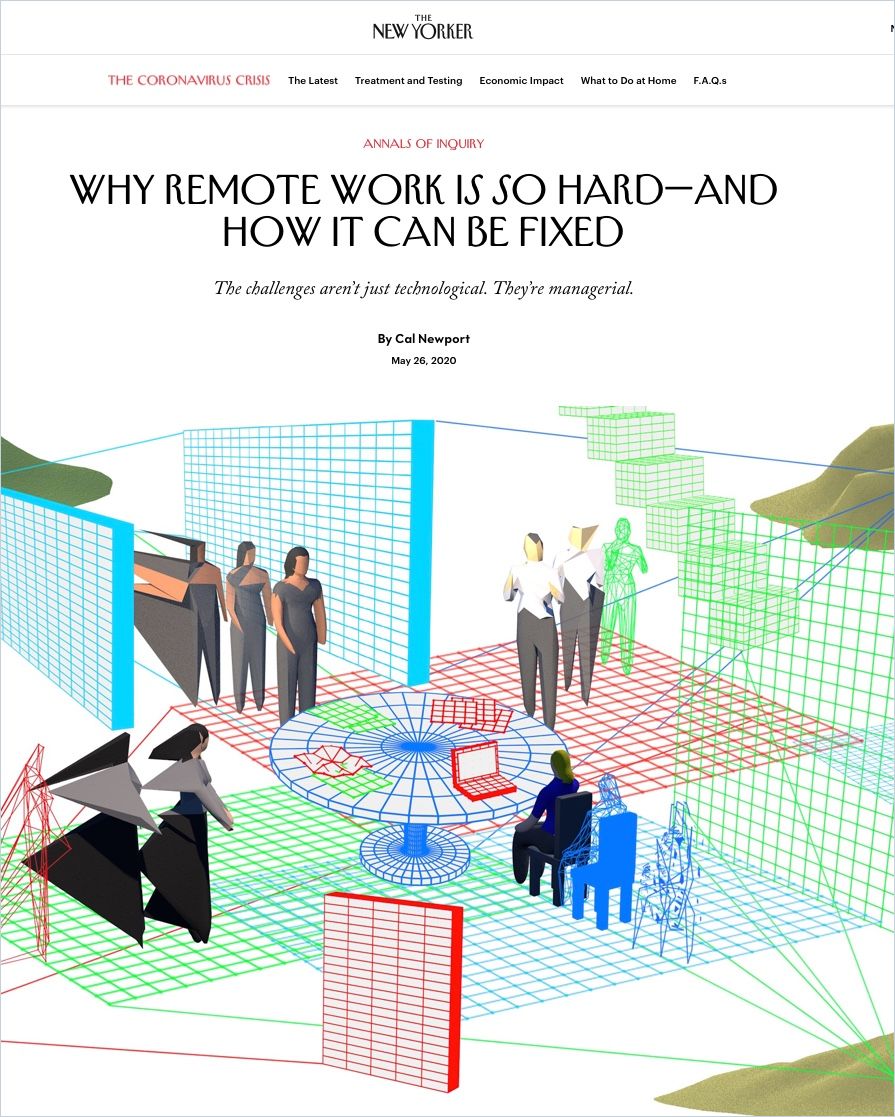“You Have to Reach People Emotionally”

Mr. von Heimburg, you published your book Virtuelle Teams erfolgreich führen (Leading Virtual Teams Successfully) almost 20 years ago. When you look back: What were virtual teams like at that time? It wasn’t that popular yet, was it?
York von Heimburg: No, it wasn’t popular at all. At least not across the board. But it was essential for me back then – I worked in a global company and my employees were spread worldwide, hence my early involvement with the topic. But you’re undoubtedly right. The timing of this book was certainly too early for a broad readership.
How did virtual collaboration work 20 years ago – and what laws still apply today?
Leadership, of course, also means communication, and in all its facets. Establishing contact, dealing with people, leading them, motivating them, inspiring them, coaching them and being present. At that time, a lot of those things were done via email, telephone or cumbersome videoconferencing systems, which were time-consuming and expensive. And in principle, we never used the latter techniques. We communicated via the good old telephone and email, or we met once a year somewhere in the world or every three months in regional meetings. We shared many best practices there, including discussions about the best strategy to make the company even more attractive for the customers.
Two decades later, what has changed significantly for you in leading virtual teams?
It is much more evident in companies today that teamwork is a fundamental issue. This has to do with the fact that the problems and the challenges are becoming more complex. And the more complex the problems become – i.e., the more people have to work together to deal with these issues – the more teamwork comes into focus. Today, teams are also put together with diversity and inclusion in mind; today, you solve problems with people from various backgrounds and cultures. Twenty years ago, things were – if I may put it this way – more one-dimensional. So you talked one-to-one, and that’s how you tried to influence workflows. Today, you talk one-to-many to cover the entire problem and all the challenges – and then they’re dealt with jointly by different people.
What are the essential tasks facing managers of a virtual team?
It’s about being an effective initiator and organizer of calls and video conferences. You have to be creative in finding the relevant starting points and topics that help the virtual teams; you have to define the framework for action for the teams; you have to provide the teams with the sufficient resources and the necessary freedom; and you have to give well-being support and provide assistance in the event of differences or difficulties. It is vital to ensure that the team’s work progress is documented, monitored, and discussed, again and again, to orient the focus of the virtual team’s tasks to the situation if necessary. This takes time, but the good results justify the effort. To do this, you need to reach people emotionally. It helps if you think about how human interaction works, how to bring emotionality to video calls. Among other things, this often means coming up with a different format: Get away from what’s usually done. That could be virtual wine tastings, cooking together… things that move entirely away from pure knowledge transfer. Because, seriously:
If someone has 15 calls a day – and that often happens enough – in the evening, they no longer know where right and left are.
York von Heimburg
As a manager, I have to bring new professional and social skills to the table. Which ones?
You have to communicate effectively. And sustainable in the sense that the communication has an impact. And that isn’t easy with five, 10, 15 calls or meetings a day. You have to respond to your target group, your counterpart. You can’t always expect feedback from your colleagues but not deliver it yourself. Listen to people. Be mindful of feelings. How does the other person, the person on the screen, feel? How does this person appear? Empathy is a new fundamental skill. And curiosity – you have to be curious about your counterpart. I find that, again and again, people in such video calls do not listen, or listen insufficiently. They all have their message in mind, and it’s all about placing it.

To then go into the next call…
Exactly. And that’s a shame for every call. It doesn’t do much good that way. The same goes for the necessary preparation: Many people don’t do it because they don’t have time or don’t even know it’s essential. You need to formulate your message in advance. You need to state what you want and clearly.
On the other hand, you need clear feedback. Create a space and framework so that people are willing to reflect their opinion. It takes trust so that the person being told something can give feedback without fear. This is the only way to have discussions in which problems and challenges can be solved.
Are there any no-gos in video calls?
I’m a little unconventional about it. I don’t care if someone wears jeans or a suit if that’s what you mean. Also, this thing with screen backgrounds – there’s a lot of bells and whistles. I prefer to keep it authentic, but how the other person does it is fine by me. What there must not be, in my eyes, is boredom – for example, when someone talks for 45 minutes and there is no discussion. Concentration is also significant: No cell phone games on the side, as [German politician] Mr. Ramelow has done, according to his statements, in minister-president conferences.
And team managers should always strive to keep people’s attention. If that doesn’t work, you’d better break off and restart the call. Also, keep in mind that different countries use different technologies and have additional technological requirements. Especially with videoconferencing, some specific tools or providers don’t work in other parts of the world. If you do use them, people there can feel excluded.

How much time do you currently spend on video calls?
At the media company IDG, I had up to 15 video calls across different time zones in one day, sometimes from early morning to midnight. Today, it’s significantly fewer calls, but still a relatively large number. But I try to limit that. Of course, managers are only useful when they ultimately communicate what they have in mind. Also, managers must not let the development of new ideas slide. It takes time to conceive new ideas. Indeed, it helps if you have the exchange with others in parallel, and videoconferencing is very suitable for this. But here, too, the focus should be on brainstorming and developing new ideas.
Until now, the user or IT support has taken care of everything in many companies; now it’s also important for managers not to let employees down at home.
York von Heimburg
Regarding the timing of video calls, I believe you should be very disciplined. After all, 15 hours of videoconferencing, more or less at a stretch – in my eyes, operationally, that is just purely hectic.
Keyword – control. With virtual teams, especially now with the widespread home office, the question often arises: How can I make sure that my employees do their work?
In my opinion, control rarely works. It’s more about motivating people and interacting emotionally. You have to give them the foundation to manage their stuff on the day as well. Right now, you have to give people the time and necessary support for them to combine their domestic and professional duties in a practical way. You can achieve outstanding results with this. Micromanagement, on the other hand, is not very successful.

How do you feel about control?
I don’t do to anyone else what I wouldn’t want for myself. Total control doesn’t help at all. Create a motivating environment – you’ll achieve much more with empathy and motivation, and above all, you get better results.
You talked about the conditions that have to be created to work in a home office. The technical requirements certainly play a role here. How have you experienced the digital upgrade of companies in the pandemic?
As I said initially, IDG has always been an international company and has been operating globally for 60 years. So our employees already had the technical capabilities available to them. For many others, however, it was indeed the case that the prerequisites were lacking. We also had to upgrade our technology and train our employees.
They should set aside clear, fixed times per day for video calls and virtual leadership, but not exceed them.
York von Heimburg
That is certainly not an easy undertaking, but it is an important one. In a nutshell, the devices must be available, the connection to the internet must be up and running, and the same applies to the link to the corporate network. All of this must run smartly and without problems. Not to be forgotten: Contact with the customer! This, too, must be guaranteed when employees are working within their own four walls.
The often close quarters at home and the lack of workspace are a real challenge for many in the home office...
Of course, that’s a whole other issue. Every company can solve the technology issue somehow and usually relatively quickly. Still, if you are in a two- or three-room apartment with a husband who is also in the home office and two children who are not allowed to go to school, it becomes difficult to organize. You’ll probably need a schedule so that you can manage it in a reasonably efficient and stress-free way so that everyone can do their job successfully. Let’s take videoconferencing as an example: Holding two in parallel at just one table doesn’t work. That’s where you should work out concrete schedules. The same applies to child care, if possible.

But there you also need flexibility on the part of the company.
Yes. Employees need to be empowered and able to work flexibly and with self-direction. To do that, employers need to develop a high level of trust in employees’ abilities and unique ways of working. This applies quite specifically to the individual organization of working time per day – or better, per week. Especially now, managers need to communicate goals and strategies transparently, and repeatedly, because this is the only way employees will be able to work efficiently toward the goals independently and take responsibility for them. This is not easy in a virtual environment, but it is feasible. Another vital aspect is encouraging employees to collaborate again and again so that they learn to solve problems together.
Finally, how do I manage to keep my corporate culture and values alive even during home office and remote work?
To do this, employees must interact with you as a manager via video call and exchange ideas with each other. This can also happen in a virtual room, but you should motivate them to do so! Try it beyond the desk set-up: for example, the company theater group can continue virtually, sports can take place outside together. People mustn’t become lonely these days. They need to feel part of a community because the sense of community is ultimately the basis for all cooperation within the company and in relationships with customers.
About the author
York von Heimburg was President International of IDG Communications for the last three years. He has written numerous books and was a board member of the Association of German Consumer Magazines for many years.






